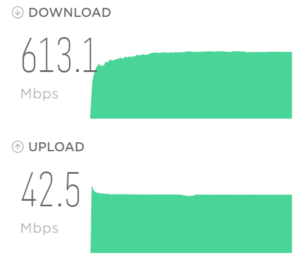
The executive summary for this blog article is that ethernet is faster than 5-gigahertz wifi, and 5-gigahertz wifi is faster than 2.4-gigahertz wifi. (I imagine that most readers of this blog already expected this to be the case.)
For this blog article, my testing took place in a two-story house that has a thick concrete floor between the two stories. There is an access point on the upper story, and there is an access point on the lower story. Each access point offers 2.4-GHz wifi and 5-GHz wifi. I positioned myself very nearby to the upper-story access point, with a direct line of sight to it. The lower-story access point was on the other side of the thick concrete floor.
The WAN (wide area network) connection was cable internet, with a tier of service offering up to 1 gigabits per second down and up to 35 megabits per second up. Another way to say this is that the service was strikingly asymmetic, by a factor of about 30 to 1.
The access points each promise MIMO (Wikipedia article), meaning that if a connected device has MIMO, then the connected device may be able to negotiate a connection with the access point so that two or more distinct (hopefully largely orthogonal) RF data paths can be employed.
The ethernet in this house is all gigabit ethernet.
I used three speed tests — a Comcast (Xfinity) speed test, a Centurylink speed test, and an Ookla speed test. I carried out each speed test multiple times, while connected using any of the five LAN connections (ethernet, upstairs 2.4-MHz, downstairs 2.4-MHz, upstairs 5-MHz, and downstairs 5-MHz). This table shows representative speed test results for the various tests.
| Download speed | Upload speed | ||||
| Centurylink | Comcast | Ookla | Centurylink | Ookla | |
| Downstairs 2.4 GHz | 76 | 80 | 76 | 42 | 42 |
| Downstairs 5 GHz | 569 | 465 | 429 | 42 | 42 |
| Upstairs 2.4 GHz | 77 | 74 | 72 | 42 | 42 |
| Upstairs 5 GHz | 568 | 469 | 415 | 42 | 42 |
| ethernet | 886 | 891 | 871 | 42 | 42 |
Upload speeds. The first thing that jumps out here for me is the upload speed situation. As you can see, so far as upload speeds are concerned, it absolutely did not matter which way I connected — access point near or access point distant, 2.4-gig or 5-gig, ethernet or wifi. Always the upload speed was 42 megabits per second. It is quite clear that the source of this “42” number is the WAN upload speed. One way to say this is that the bottleneck for upload is in the WAN connection, not in the type of LAN connection being used. Another way to say this is that so far as upload is concerned, each of the LAN connections (wifi, ethernet) had potential faster bandwidth that was not being put to use.
Ethernet wins. It jumps off the page that the wired ethernet connection is strikingly faster than any wifi connection so far as download speeds are concerned. (If the WAN upload speed had been faster then this bottleneck 42M speed, then we would also have seen the ethernet upload being faster than any of the wifi upload speeds.)
5 Gigahertz wins. It also jumps off the page that if for some reason the user is unable or unwilling to use an ethernet connection, then the next best choice is a 5-GHz wifi connection. The 5-GHz wifi is consistently around six to eight times faster than the 2.4-GHz wifi.
2.4 Gigahertz is more than acceptable. It should also be appreciated that even though the 2.4-GHz speeds are strikingly slower than the 5-GHz speeds, they are nonetheless completely acceptable. Even the most demanding videoconference connections, for example, never require more than perhaps 5M up and 5M down.
Choice of access point makes no difference. For me the single most striking observation is that for these tests, it absolutely did not matter whether I was connecting to an access point that was in a direct line of sight, or to an access point that was on the other side of a thick concrete floor. The speeds for the 2.4-GHz wifi and for the 5-GHz wifi were about the same with or without the concrete floor in the way.
A few other comments may be in order. If I had been using an older laptop computer that lacked MIMO, then the 5-GHz speed test results would have been strikingly slower, perhaps by half. The speed advantage for 5-GHz over 2.4-GHz would have been correspondingly smaller.
If I had been at a much greater distance from the access points, then the speed advantage for 5-GHz would have been smaller, because the lower-frequency radio signals penetrate walls and floors and other obstacles better than the higher-frequency signals.
These test results offer a reminder that it is just as well to configure an ethernet LAN so that everything about the LAN is able to run at gigabit speeds. In the old days, this was an expensive thing to do, because (for example) gigabit ethernet switches had a strikingly higher cost per port than (for example) 100 megabits-per-second ethernet switches. But nowadays, gigabit switches do not cost much more than 100M switches.
Maybe some readers have carried out similar speed tests in their own homes or offices. If so, I welcome comments below about your findings.
